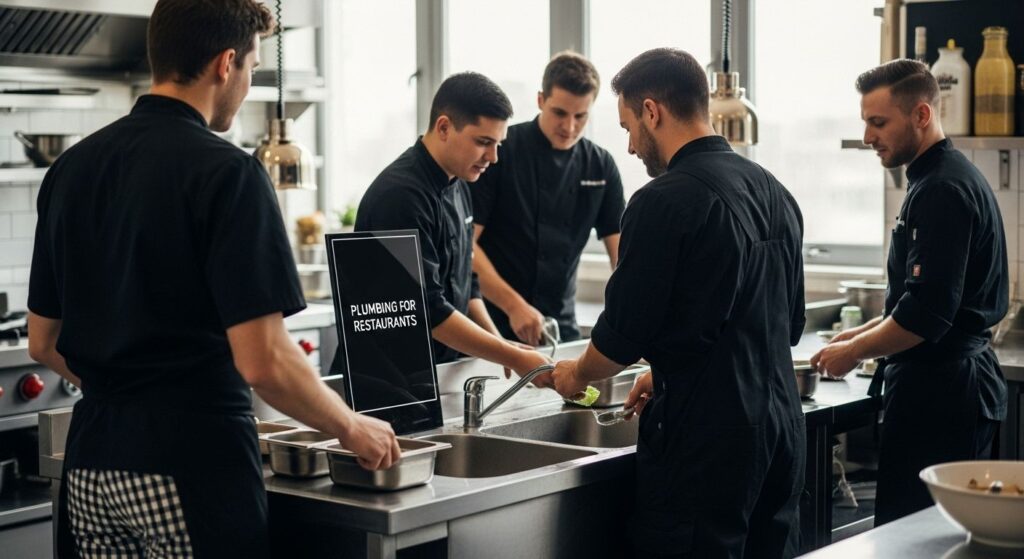Restaurant plumbing keeps kitchens running, but most people overlook how complicated these systems really are. The difference in scale is massive and the average commercial kitchen uses up to 10 times more water per day than a typical home. That sounds extreme, right? The real shock is that even one plumbing breakdown can bring a whole restaurant to a standstill and potentially shutter the doors due to health code violations.
Table of Contents
- What Is Plumbing For Restaurants And Its Importance?
- Key Components Of Restaurant Plumbing Systems
- Common Plumbing Issues Faced By Restaurants
- How Plumbing Affects Restaurant Operations And Health
- Best Practices In Restaurant Plumbing Management
Quick Summary
| Takeaway | Explanation |
|---|---|
| Invest in quality plumbing systems. | Quality plumbing is crucial for food safety, compliance, and overall restaurant functionality. It ensures smooth operations and prevents costly disruptions. |
| Implement regular preventative maintenance. | Regular inspections and systematic upkeep can significantly reduce unexpected plumbing issues, ensuring efficient restaurant operations and longevity of the systems. |
| Prioritize grease management practices. | Effective grease management is essential to prevent blockages and health code violations, which can jeopardize restaurant operations and safety. |
| Understand contamination risks in plumbing. | Awareness of cross-connection and contamination risks is vital. Taking preventative measures protects water quality and maintains hygiene standards in food service. |
| Train staff on plumbing hygiene protocols. | Proper staff training on waste disposal and cleaning protocols mitigates contamination risks and supports overall plumbing hygiene in the kitchen. |
What is Plumbing for Restaurants and Its Importance?
Plumbing for restaurants represents a complex and critical infrastructure system designed to support food service operations through safe water delivery, waste management, and hygienic environmental conditions. Unlike residential plumbing, restaurant plumbing systems must meet stringent health and safety regulations while handling significantly higher water volumes and unique operational demands.
Core Components of Restaurant Plumbing Systems
Restaurant plumbing encompasses several specialized subsystems that work together to maintain seamless kitchen and dining area functionality. These systems include potable water supply lines, drainage networks, grease management infrastructure, and specialized fixtures designed for high-volume commercial environments.
Below is a table outlining the core components of restaurant plumbing systems along with their primary functions to provide a clear overview of each part’s purpose.
| Component | Function |
|---|---|
| Water supply lines | Deliver potable water from municipal sources to various zones |
| Specialized drain systems | Direct liquid and waste away from equipment and preparation areas |
| Grease interceptors | Trap grease and fatty waste to prevent pipe blockages |
| Commercial kitchen fixtures | Facilitate food preparation and cleaning at high volumes |
| Backflow prevention mechanisms | Prevent contaminated water from entering the clean supply lines |

Key components within restaurant plumbing systems involve:
- Water supply lines connecting to municipal water sources
- Specialized drain systems for kitchen equipment
- Grease interceptors preventing pipe blockages
- Fixtures designed for commercial food preparation areas
- Backflow prevention mechanisms
Importance of Proper Restaurant Plumbing
Proper plumbing is fundamental to restaurant operations, directly impacting food safety, health compliance, and overall business functionality. Research from the National Restaurant Association indicates that inadequate plumbing can result in significant health code violations, potential business closure, and substantial financial penalties.
Restaurant owners must recognize that their plumbing system represents more than just water infrastructure. It is a critical operational backbone that supports food preparation, sanitation, and customer experience. Consistent maintenance and professional inspection of commercial plumbing systems can prevent costly disruptions and ensure continuous, safe restaurant operations.
The complexity of restaurant plumbing demands specialized knowledge, professional installation, and routine maintenance to guarantee optimal performance and compliance with local health regulations. Investing in quality plumbing is not an expense but a fundamental requirement for sustainable restaurant management.
Key Components of Restaurant Plumbing Systems
Restaurant plumbing systems represent a sophisticated network of interconnected components designed to ensure safe, efficient, and hygienic food service operations. These systems go far beyond simple water delivery, integrating complex infrastructure that supports multiple critical functions within a commercial kitchen environment.
Water Supply and Distribution Systems
The foundation of restaurant plumbing begins with robust water supply and distribution networks. These systems must deliver consistent, clean water at appropriate temperatures and pressures to various kitchen zones. Exploring our comprehensive guide on plumbing systems reveals the intricate design required for commercial food preparation environments.
Critical water supply components include:
- High capacity municipal water connection
- Pressure regulation mechanisms
- Temperature control valves
- Filtration and purification systems
- Separate hot and cold water lines
Drainage and Waste Management Infrastructure
Drainage systems in restaurants represent more than standard waste removal. They require specialized design to handle high volume liquid waste, food particles, and potential grease accumulation. According to research from Sonoma County Health Services, proper drainage prevents potential health hazards and maintains operational hygiene.
Key drainage components include:
- Grease interceptors
- Floor drains with specialized traps
- Commercial grade drain pipes
- Backflow prevention mechanisms
- Solids separation systems
Effective restaurant plumbing requires precision engineering that balances hydraulic performance, sanitation standards, and operational efficiency. Each component must work seamlessly to support the complex demands of commercial food preparation environments, ensuring both regulatory compliance and optimal kitchen functionality.
Common Plumbing Issues Faced by Restaurants
Restaurant plumbing systems are subjected to extreme operational demands that make them particularly vulnerable to specific challenges. The high-volume, continuous usage creates unique stress points that can compromise system integrity and potentially disrupt critical food service operations.
The following table compares common plumbing issues faced by restaurants with their potential consequences, helping readers understand risks to operations and compliance.
| Common Issue | Potential Consequences |
|---|---|
| Grease and waste accumulation | Persistent blockages, sewage backups, increased maintenance costs |
| Pipe corrosion from fatty waste | Pipe failure, expensive repairs, water leaks |
| Backflow and cross-contamination risk | Water supply contamination, health code violations |
| Poor separation of water lines | Chemical contamination, compromised water quality |
| Aging or poorly maintained infrastructure | Service interruptions, reputation damage, temporary closures |
Grease and Waste Accumulation Challenges
Grease management represents one of the most significant plumbing challenges in restaurant environments. Commercial kitchens generate substantial amounts of fatty waste that can rapidly accumulate in drainage systems, creating potential blockages and sanitation risks. Learn more about commercial plumbing challenges to understand the complexity of these issues.
Potential consequences of inadequate grease management include:
- Persistent drain blockages
- Increased risk of pipe corrosion
- Potential sewage backups
- Higher maintenance and repair costs
- Potential health code violations
Critical Contamination and Cross Connection Risks
According to research from the National Academies Press, restaurant plumbing systems face significant risks related to potential water contamination and cross connection problems. These risks emerge from complex interactions between potable water systems and potential contamination sources within commercial kitchen environments.
Key contamination risk areas include:
- Improper backflow prevention
- Inadequate separation of water lines
- Potential chemical contamination points
- Compromised water filtration systems
- Aging or poorly maintained infrastructure
Restaurant owners must recognize that plumbing issues are not merely technical problems but potential threats to business continuity, food safety, and operational reputation. Proactive maintenance, regular professional inspections, and immediate response to emerging issues are essential strategies for mitigating these complex challenges.
How Plumbing Affects Restaurant Operations and Health
Plumbing systems serve as the critical backbone of restaurant functionality, directly influencing operational efficiency, food safety standards, and overall customer health. The intricate network of pipes, fixtures, and water management infrastructure represents far more than simple utility infrastructure.
Direct Impact on Food Safety Protocols
Restaurant plumbing systems play a fundamental role in maintaining rigorous food safety standards. Contamination risks emerge from potential cross connections, inadequate water temperatures, and compromised drainage systems. Explore the critical health considerations in plumbing systems to understand the nuanced risks restaurants face.
Key food safety considerations include:
- Preventing water supply contamination
- Maintaining appropriate water temperatures
- Ensuring proper waste management
- Eliminating potential bacterial growth zones
- Supporting consistent sanitation practices
Operational Efficiency and Business Continuity
According to research from the Food Safety and Inspection Service, plumbing systems directly influence a restaurant’s ability to maintain continuous operations. Malfunctioning plumbing can result in immediate service interruptions, potential health code violations, and significant financial losses.
Operational risks associated with plumbing failures include:
- Unexpected kitchen service disruptions
- Potential temporary business closure
- Substantial repair and remediation costs
- Negative impacts on restaurant reputation
- Loss of customer trust and potential revenue
Restaurant owners must recognize that plumbing is not merely an infrastructural element but a critical component of their business’s overall health, safety, and operational sustainability. Proactive maintenance, regular professional inspections, and immediate response to emerging issues are essential strategies for mitigating potential risks and ensuring continuous, safe food service operations.
Best Practices in Restaurant Plumbing Management
Restaurant plumbing management requires a strategic, proactive approach that goes beyond routine maintenance. Successful implementation involves comprehensive systems, staff training, and consistent monitoring to prevent potential operational disruptions and health risks.
Preventative Maintenance Strategies
Preventative maintenance forms the cornerstone of effective restaurant plumbing management. Regular inspections, systematic documentation, and anticipatory repairs can significantly reduce unexpected failures and costly interventions. Explore our comprehensive commercial plumbing maintenance guide to understand the critical elements of systematic plumbing care.
Key preventative maintenance components include:
- Scheduled professional plumbing assessments
- Comprehensive system documentation
- Regular equipment performance tracking
- Predictive maintenance technology implementation
- Proactive repair and replacement planning
Hygiene and Contamination Prevention Protocols
According to research from the San Antonio Water System, restaurant plumbing management must prioritize rigorous hygiene protocols to prevent potential contamination and system degradation. This involves implementing strategic practices that minimize grease accumulation, bacterial growth, and cross contamination risks.
Critical hygiene management practices include:
- Training kitchen staff on proper waste disposal
- Installing and maintaining grease interceptors
- Implementing strict cleaning protocols
- Using sink strainers to prevent solid waste accumulation
- Maintaining comprehensive maintenance logs
Effective restaurant plumbing management transcends basic maintenance, representing a holistic approach to operational sustainability, health safety, and long term business resilience. Successful implementation requires continuous learning, technological adaptation, and a commitment to systematic, proactive care.

Keep Your Restaurant Running Smoothly—Partner With Leaders in Plumbing Reliability
Restaurants face a unique set of plumbing challenges, from grease build-up and drainage issues to the constant risk of operational shutdowns due to maintenance failures. As explained in our article, even a minor plumbing problem can quickly escalate into a major threat to food safety, customer trust, and your bottom line. If you want to prevent costly closures and keep your kitchen compliant with health regulations, you need experienced professionals who understand the demands of commercial environments. Explore our Uncategorized restaurant plumbing solutions for an insider look at how we tackle these specific restaurant concerns.

Take control of your plumbing systems before problems disrupt your business. The team at Delta Plumbers Ottawa is available 24/7 with flat-rate pricing and a one-year warranty. Discover fast, reliable, and tailored solutions to keep your restaurant safe, compliant, and open. Contact us now and experience the difference true commercial plumbing expertise can make.
Frequently Asked Questions
What are the main components of plumbing systems in restaurants?
Restaurant plumbing systems consist of several key components, including water supply lines, drainage networks, grease interceptors, specialized fixtures for food preparation, and backflow prevention mechanisms.
How does proper plumbing impact food safety in restaurants?
Proper plumbing is essential for maintaining food safety by preventing water contamination, ensuring appropriate water temperatures, managing waste effectively, and eliminating zones that could promote bacterial growth.
What are common plumbing issues faced by restaurants?
Common plumbing issues in restaurants include grease and waste accumulation leading to blockages, contamination risks from improper backflow prevention, and potential pipe corrosion due to high volumes of fatty waste.
What preventative maintenance strategies should restaurants implement for their plumbing?
Restaurants should implement scheduled professional plumbing assessments, maintain comprehensive system documentation, and train staff on proper waste disposal and cleaning protocols to prevent plumbing failures and ensure operational efficiency.









